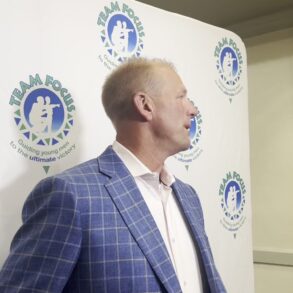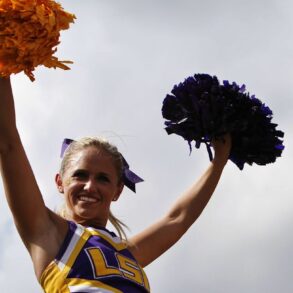
In college football, games and legacies can be decided by a matter of inches.
Throughout much of college football history, even a single loss could derail a team’s hopes for a national championship. A tipped pass, a bad call, or an unlucky ball bounce can flip a game’s outcome in one-score games.
Inspired by the Nebraska Cornhuskers’ historic trend of losing so many close games over the last decade, I decided to dive into college football history to see how different the sport might look if the outcome of every one-score game was flipped season by season.
Welcome to ‘What If: The 1980 Season’.
Other What If seasons: 1973, 1974, 1975, 1976, 1977, 1978,1979
The 1980 season began with blue bloods at the top of the standings. The Nebraska Cornhuskers opened the season No. 7, but faced a daunting schedule with four of their 11 opponents ranking in the preseason top 18. The first few weeks saw no major shakeups to the AP Top 20 teams, but the final week of September shook up the top of the standings. Top-five Oklahoma lost to John Elway and Stanford in Norman. Nebraska ended the opening month with a big win at Penn State.
October would start with another major shakeup to the standings. No. 2 Ohio State lost at home to UCLA, while the Huskers had a letdown game to Florida State with a turnover in the final seconds of the game. Alabama would carry the top spot in the polls through October before an early November loss to Mississippi State. Notre Dame would take over the top spot for just one week before a tie with Georgia Tech would move the Georgia Bulldogs to number one for the remainder of the regular season.
The Heisman once again went to the nation’s best running back. South Carolina’s George Rogers led the nation in both rushing yards and yards from scrimmage. The second-place finisher was Pitt defensive lineman Hugh Green, while the freshman phenom Herschel Walker finished third.
Unbeaten Teams: Georgia (11-0)
The Big 10 and Big Eight came down to the final two teams, as they usually did, with Oklahoma and Michigan narrowly beating out Nebraska and Ohio State. It would be the second heartbreaking loss by the Cornhuskers in the final minute of the game this season. Washington won the Pac-10 for the second time in four seasons for a matchup with the Wolverines. Baylor won the Southwest Conference, giving it an automatic berth to the Cotton Bowl.
In 1980, not all bowl bids were determined after the regular season. Notre Dame was already invited to a matchup with Georgia in the Sugar Bowl for a one vs two championship game. The only problem was that Notre Dame lost its final game to USC. As a result, the second-place 10-1 Florida State Seminoles played Oklahoma in the Orange Bowl. The bowl selection system also left Dan Marino’s Pitt Panthers out of the New Year’s Day bowl games. Bear Bryant’s Alabama was selected to go to the Cotton Bowl before Pitt’s signature win over Penn State to end the season.
|
Bowl |
Winner |
Loser |
|---|---|---|
|
Sugar Bowl |
Georgia (11-0) 17 |
Notre Dame (9-1-1) 10 |
|
Orange Bowl |
Oklahoma (9-2) 18 |
Florida State (10-1) 17 |
|
Rose Bowl |
Michigan (9-2) 23 |
Washington (9-2) 6 |
|
Cotton Bowl |
Alabama (9-2) 30 |
Baylor (10-1) 6 |
Georgia’s victory over the Fighting Irish all but guaranteed the Dawgs a national championship. They would finish as the sole unbeaten team in the nation and were crowned the national champions in both the AP and Coaches polls.
The biggest winner from this exercise is the Ole Miss Rebels. They gained five wins from the exercise, improving from 3-8 to 8-3. One of these five “flipped” wins is their matchup with the actual national champion Georgia Bulldogs. Despite shutting out three opponents, Georgia also escaped with five one-score wins during the championship run. In the hypothetical, they miss the bowl season entirely.
Our hypothetical radically alters the Heisman race. South Carolina drops by one game to only have a 7-4 record. Hugh Green and Pitt are now just 8-3 after their hypothetical record drops by two games. Herschel Walker would be well out of the Heisman discussion and just 6-5. Fourth-place finisher Mark Herrmann and his Purdue Boilermakers are now just 6-5.
BYU’s Jim McMahon would have a great case as the nation’s leading passer on an unbeaten Cougars team. Jarvis Redwine of Nebraska, who finished eighth in Heisman voting, would likely get more attention from voters with the Cornhuskers’ undefeated record. Jim McMahon obliterated the single-season passing record set by BYU quarterback Marc Wilson the season prior. I expect that McMahon would take home the Heisman with Jarvis Redwine finishing in second place despite his midseason injury.
For much of his career, Barry Switzer and the Oklahoma Sooners were a major obstacle for Tom Osborne. As in several other articles in this series, the Huskers win the Big Eight in this hypothetical scenario. The Huskers’ heartbreaking loss to the Florida State Seminoles, a game where Nebraska fumbled twice at the three-yard line in the final seconds, is also reversed in our hypothetical. As the only major conference unbeaten, the Nebraska Cornhuskers would be playing for their first title under Tom Osborne.
Unbeaten Teams: BYU (12-0), Nebraska (11-0)
BYU would be a significant wild card in the bowl process. While an Orange Bowl national championship game between Nebraska and BYU would be enticing, major bowl promoters would likely overlook BYU, as they did in 1984. Should some of the other major teams falter, the Cougars would still end up in the Holiday Bowl with an outside chance of winning a title.
The Rose Bowl would be a rematch of the Oct. 4 matchup between UCLA and Ohio State. I expect that UCLA would win the rematch after its shutout victory against Ohio State a few months prior. The Sugar Bowl would be a great matchup between the best teams in the 1980 season. Alabama would still have championship aspirations if Nebraska were to lose in the Orange Bowl. The Crimson Tide were a top-10 team on both sides of the ball in 1980. However, Bowden’s Florida State squad was in the top five. Bobby Bowden and the Seminoles would win in a close matchup.
Baylor would be crowned Southwest Conference champion thanks to its head-to-head matchup with SMU. Baylor’s opponent would be the SEC runner-up Ole Miss Rebels. Ole Miss had the most prolific passing offense in the SEC that season, whereas Baylor had the Southwest Conference’s leading rusher. While Ole Miss could keep most of its losses close (as they were the biggest improvers), they were blown out by Alabama and LSU. Walter Abercrombie and Baylor would likely win this game handily.
The 1980 Nebraska Cornhuskers are the school’s most underrated team. They lost two home games to Florida State and Oklahoma by just four points each. The next closest game was a two-touchdown win at Penn State. The Huskers finished the season as the No. 2 team in the nation in both scoring offense and scoring defense.
|
Bowl |
Winner |
Loser |
|---|---|---|
|
Sugar Bowl |
Alabama (10-1) |
Florida State (9-2) |
|
Orange Bowl |
Nebraska (11-0) |
SMU (9-2) |
|
Rose Bowl |
UCLA (10-1) |
Ohio State (9-2) |
|
Cotton Bowl |
Baylor (9-2) |
Ole Miss (8-3) |
The 1980 Nebraska offense was the school’s first team to rush for 4,000 yards in a single season. They are also the only Huskers’ defense since 1973 to allow fewer than 100 points in a season, with just 93 points allowed. No Husker offense to date had accumulated more yards than the 1980 Nebraska. Nebraska’s +342 point differential this season is still the eighth-best season mark in program history.
The SMU Mustangs still get their shot at one of the best teams in college football this season. The Pony Express, led by Eric Dickerson and Craig James, would face the Nebraska Cornhuskers in the Orange Bowl. The legendary Mustang rushing duo would be outclassed by Nebraska’s own two-headed monster of Jarvis Redwine and Roger Craig. The Huskers finished second in the nation that season with 5.6 rushing yards per attempt. Defensively, they were third in this metric, allowing just 2.1 yards per carry.
While this article series hasn’t often focused favorably on Tom Osborne and the Huskers, this installment differs. Although Tom Osborne is already a college football legend, winning a title in 1980 could have further elevated his career. The Huskers were already recruiting well, having Turner Gill and Irving Fryar on campus during the 1980 season. They would add future Heisman winner Mike Rozier in the spring of 1981. This trio would form the basis for one of the greatest offenses in college football history. There wasn’t much room for improvement in Tom Osborne’s career, but this ‘What If’ scenario could have taken him to even greater heights.
Stay up to date on all things Huskers by bookmarking Nebraska Cornhuskers On SI, subscribing to HuskerMax on YouTube, and visiting HuskerMax.com daily.
This post was originally published on this site be sure to check out more of their content.





